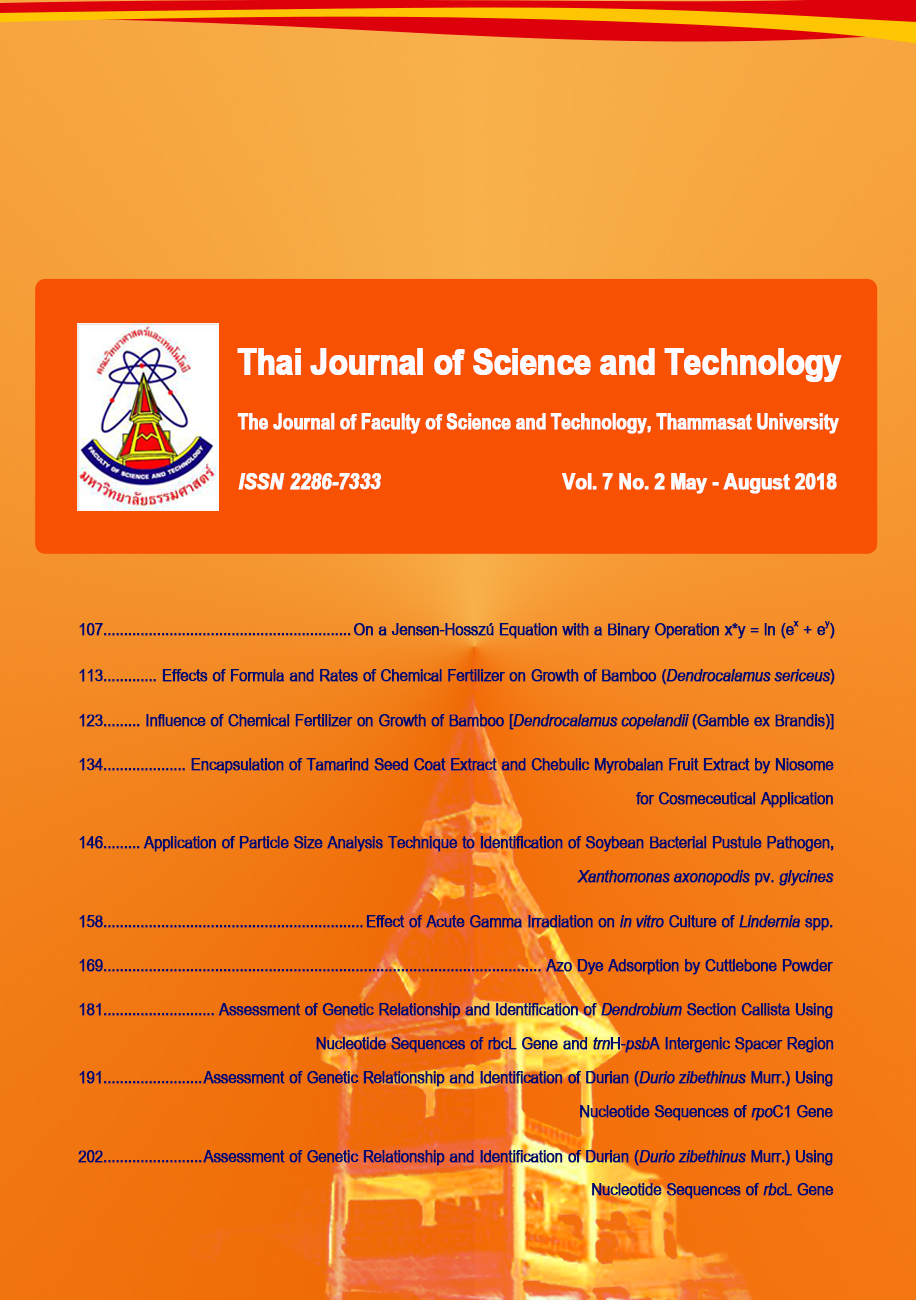การดูดซับสีย้อมเอโซโดยผงลิ้นทะเล
Main Article Content
บทคัดย่อ
บทคัดย่อ
การศึกษาประสิทธิภาพของผงลิ้นทะเลในการดูดซับสีย้อม 3 ชนิด ได้แก่ สี Reactive Red 141 (RR141) สี Sirius Red F3B (F3B) และ สี Telon Red M-3B 80 % (M-3B) โดยหาสภาวะที่เหมาะสมในการดูดซับสีย้อมความเข้มข้น 400 มิลลิกรัมต่อลิตร พบว่าขนาดของผงลิ้นทะเลที่เหมาะสมในการดูดซับ คือ 0.064-0.074 มิลลิเมตร สามารถดูดซับสีย้อม สี RR141 สี F3B และ สี M-3B ได้ร้อยละ 82.83, 97.80 และ 86.25 ตามลำดับ ที่ค่าความเป็นกรด-ด่างเริ่มต้นเท่ากับ 6.8-7.0 ประสิทธิภาพการดูดซับสีทั้ง 3 ชนิดด้วยผงลิ้นทะเลจะเพิ่มขึ้นในสภาวะความเป็นกรด (pH = 2.0) นอกจากนี้พบว่าผงลิ้นทะเลดูดซับสีย้อมทั้ง 3 ชนิด ได้สูงที่ความเข้มข้นที่แตกต่างกัน คือ สี RR141 ความเข้มข้น 200 มิลลิกรัมต่อลิตร สี F3B ความเข้มข้น 350 มิลลิกรัมต่อลิตร และสี M-3B ความเข้มข้น 100 มิลลิกรัม โดยมีค่าการดูดซับร้อยละ 99.4, 99.70 และ 96.07 ตามลำดับ ประสิทธิภาพของลิ้นทะเลในการดูดซับน้ำเสียจากโรงงานฟอกย้อมมีค่าร้อยละ 59.29 ในขณะที่การดูดซับสีย้อมผสมทั้ง 3 ชนิดมีค่าร้อยละ 91.43 เมื่อเปรียบเทียบประสิทธิภาพการดูดซับสีย้อมทั้ง 3 ชนิดกับ ไคโตซานพบว่าผงลิ้นทะเลมีประสิทธิภาพการดูดซับสีย้อมใกล้เคียงกับไคโตซาน การศึกษาไอโซเทอมของการดูดซับโดยลิ้นทะเล เมื่อพิจารณาค่าสัมประสิทธิ์สหสัมพัทธ์ (R2) พบว่าค่า R2 จากทั้งสมการแลงเมียร์และสมการฟรุนดิชพบว่ามีค่าใกล้เคียงกันโดยสีย้อมทั้ง 3 ชนิด ให้ค่าความสามารถในการดูดซับสูงสุดของสีย้อมทั้ง 3 ชนิดเป็น 6.30, 9.56 และ 0.76 มิลลิกรัมต่อกรัมตัวดูดซับ ตามลำดับ นอกจากนี้ยังพบว่าน้ำสีย้อมหลังผ่านการบำบัดโดยการดูดซับด้วยลิ้นทะเลมีค่า chemical oxygen demand (COD) น้อยกว่า 80 มิลลิกรัมต่อลิตร ซึ่งสามารถปล่อยออกสู่สิ่งแวดล้อมได้ ดังนั้นงานวิจัยนี้แสดงให้เห็นว่าลิ้นทะเลซึ่งจัดเป็นของเสียจากอุตสาหกรรมอาหาร มีประสิทธิภาพในการดูดซับสีย้อม และสามารถนำไปประยุกต์ใช้ได้ในการบำบัดน้ำเสียสีสิ่งทอได้
คำสำคัญ : ลิ้นทะเล; การดูดซับ; สีย้อมเอโซ
Abstract
Adsorption ability of cuttlebone powder for removal of Reactive Red 141 (RR141), Sirius Red F3B (F3B) and Telon Red M-3B 80 % (M-3B) from aqueous solution was studied with maximum concentration of 400 mg/L. The optimum particle size of cuttlebone powder was 0.064-0.074 mm. At initial pH of 6.8-7.0, adsorption efficiencies of RR141, F3B and M-3B were 82.83, 97.80 and 86.25 %, respectively., The adsorption of dyes increased at acidic condition (pH = 2.0). In addition, the increased adsorption was shown at high concentration of the dyes. The dye concentrations with maximum adsorption of RR141, F3B and M-3B were 200 mg/L (99.40 % adsorption), 350 mg/L (99.7 % adsorption) and 100 mg/L (96.07 % adsorption), respectively. The adsorption efficiency of waste water from dyeing factory (59.25 %) was lower compared to that of the mixture of three dyes (91.43 %) by cuttlebone. Comparison the adsorption efficiencies of three dyes by cuttlebone and those by chitosan was not significantly different. Chemical oxygen demand (COD) of water after treatment by cuttlebone adsorption was lower than 80 mg/L which is safe and allowed discharging to the environment. Equilibrium isotherms for the adsorption of three dyes on cuttlebone powder were measured and analyzed by the Langmuir and Freundlich equations using a linearized correlation coefficient (R2). Both Langmuir isotherm and Freundlich isotherm demonstrated that the maximum adsorption capacities of three types of dye were 6.30, 10.56 and 0.76 mg/g. In conclusion, the cuttlebone, a by-product from food industries, could be suggested as an effective adsorbent for the treatment of dye wastewater.
Keywords: cuttlebone, adsorption, Azo dye
Article Details
บทความที่ได้รับการตีพิมพ์เป็นลิขสิทธิ์ของคณะวิทยาศาสตร์และเทคโนโลยี มหาวิทยาลัยธรรมศาสตร์ ข้อความที่ปรากฏในแต่ละเรื่องของวารสารเล่มนี้เป็นเพียงความเห็นส่วนตัวของผู้เขียน ไม่มีความเกี่ยวข้องกับคณะวิทยาศาสตร์และเทคโนโลยี หรือคณาจารย์ท่านอื่นในมหาวิทยาลัยธรรมศาสตร์ ผู้เขียนต้องยืนยันว่าความรับผิดชอบต่อทุกข้อความที่นำเสนอไว้ในบทความของตน หากมีข้อผิดพลาดหรือความไม่ถูกต้องใด ๆ
เอกสารอ้างอิง
มั่นสิน ตัณฑุลเวศม์, 2542, เทคโนโลยีบำบัดน้ำเสียอุตสาหกรรม เล่ม 1, บริษัท แซน. อี. 68 คอนซัลติ้ง เอ็นจิเนียร, กรุงเทพฯ, 245 น.
รวินทร์ สุทธะนันท์ และโกวิทย์ ปิยะมังคลา, 2551, จลนศาสตร์และเทอร์โมไดนามิกส์การดูดซับเมทิลีนบลูโดยใช้เปลือกถั่วลิสง, ว.วิจัยและพัฒนา มจธ. 4: 751-763.
รวินทร์ สุทธะนันท์ และโกวิทย์ ปิยะมังคลา, 2554, จลนศาสตร์และเทอร์โมเคมีการดูดซับเมททิลีนบลูโดยใช้แกลบดัดแปร, ว.วิชาการพระจอมเกล้าพระนครเหนือ 2: 337-348.
รวินิภา ศรีมูล, 2559, การบําบัดสีย้อมในน้ำเสียด้วยกระบวนการดูดซับ, ว.วิทยาศาสตร์ มข. 44: 419-434.
สุธิดา คงทอง, 2552, ไคติน-ไคโตซาน, ว.วิชาการอุตสาหกรรมศึกษา 3(1): 1-7.
อุษณีย์ รักษ์ไชยวรรณ, ยุพดี กูลรัตน์กิตติวงศ์ และโกวิทย์ ปิยะมังคลา, 2557, สมดุลและจลนศาสตร์การดูดซับไอออนเงินโดยไคโตซานผสมพอลิไวนิลแอลกอฮอล์เรซิน, ว.วิศวกรรมศาสตร์ มหาวิทยาลัยศรีนครินทร วิโรฒ 9: 12-22.
Ben Nasr, A., Walha, K., Charcosset, C. and Ben Amar, R., 2011, Removal of fluoride ions using cuttlefish bones, J. fluorine Chem. 132: 57-62.
Boonurapeepinyo, S., Jearanaikoon, N. and Sakkayawong, N., 2011, Reactive red (RR141) solution adsorption by nanochitin particle via XAS and ATR-FTIR techniques, Int. Trans. J. Eng. Manag. Appl. Sci. Technol. 2: 461-470.
Dogan, M., Abak, H. and Alkan, M., 2009, Adsorption of methylene blue onto hazelnut shell: kinetics, mechanism and activation parameters, J. Hazard. Mater. 164: 172-181.
Eichlerova, I., Homolka, L. and Nerud, F., 2006, Synthetic dye decolorization of white rot fungus Dichomitus squalens, Biores. Technol. 97: 2153-2159.
Gregor, K.H., 1992, Oxidative decolorization of textile waste water with advanced oxidation processes, pp. 161-193, In Chemical Oxidation Volume II: Proceeding of the Second International Symposium Chemical Oxidation: Technology for the Nineties.
Iqbal, J., Wattoo, F.H., Wattoo, M.H.S., Malik,
R., Tirmizi, S.A., Imran, M. and Ghangro, A.B., 2011, Adsorption of acid yellow dye on flakes of chitosan prepared from fishery wastes, Arabian J. Chem. 4: 389-395.
Mahmoodi, N.M., Selehi, R., Arami, M. and Bahrami, H., 2011, Dye removal from colored textile wastewater using chitosan in binary systems, Desalination 267: 64-72.
Qu, Y., Cao, X., Ma, Q., Shi, Sh., Tan, L., Li, X., Zhou, H., Zhang, X. and Zhou, J., 2012, Aerobic decolorization and degradation of acid red b by a newly isolated Pichia sp.
TCL, J. Hazard. Mater. 223: 31-38.
Santos, A.B., Cervantes, F.J. and Lier, J.B., 2007, Review paper on current technologies for decolourization of textile wastewaters: perspectives for anaerobic biotechnology, Bioresour. Technol. 98: 2369-2385.
Sureyya, M., Deniz, K. and Tugba, O., 2004, Color and COD removal from wastewater containing reactive black 5 using Fenton’s oxidation process, Chemosphere 54: 435-441.
Wan Ngah W.S., Kamari A. and Koay Y.J., 2004, Equilibrium and kinetics studies of adsorption of copper (II) on chitosan and chitosan/PVA beads, Int. J. Biol. Macromol. 34: 155-161.


